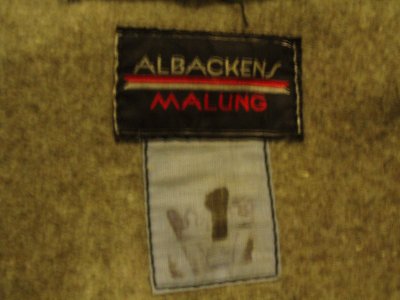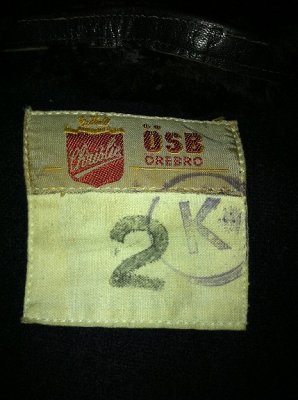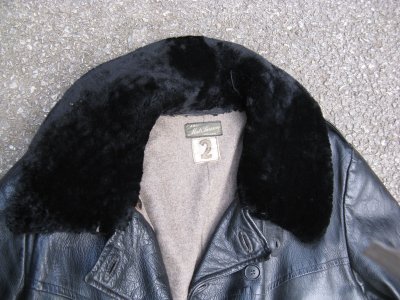Want to buy or sell something? Check the classifieds
-
The Fedora Lounge is supported in part by commission earning affiliate links sitewide. Please support us by using them. You may learn more here.
You are using an out of date browser. It may not display this or other websites correctly.
You should upgrade or use an alternative browser.
You should upgrade or use an alternative browser.
Veg v. Chrome Tanning
- Thread starter Superfluous
- Start date
- Status
- Not open for further replies.
alsendk
A-List Customer
- Messages
- 427
- Location
- Zealand Denmark
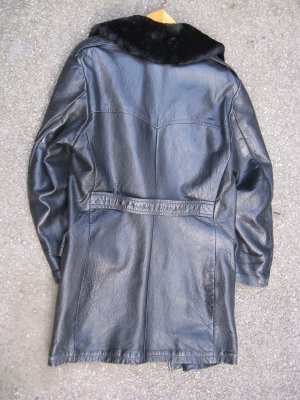
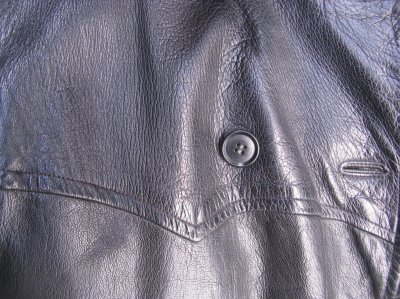
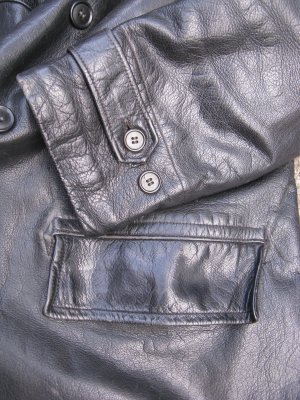
Last summer I bought a swedish military leather coat anno 1950. The seller was a little unsure whether it was goat or horse hides. What say you ? I tend to believe the hides, used just for the back, would be too large for being goat. Would the grain give away from which animal this very thick coat comes from....and would it most likely be a chrome tanning, used for a coat dated 1950 ?
please double click at pics. for inspecting the grain at close range
Allan
Last edited:
lkalliance
New in Town
- Messages
- 44
- Location
- Twin Cities area, MN
Well it's a sine of the times...
*trying to think of an isosceles joke*
*failing*
Featured products
-
 John Lofgren Monkey Boots Shinki Horsebuttt - $1,136 The classic monkey boot silhouette in an incredibly rich Shinki russet horse leather.
John Lofgren Monkey Boots Shinki Horsebuttt - $1,136 The classic monkey boot silhouette in an incredibly rich Shinki russet horse leather. -
 Grant Stone Diesel Boot Dark Olive Chromexcel - $395 Goodyear welted, Horween Chromexcel, classic good looks.
Grant Stone Diesel Boot Dark Olive Chromexcel - $395 Goodyear welted, Horween Chromexcel, classic good looks. -
 Schott 568 Vandals Jacket - $1,250 The classic Perfecto motorcycle jacket, in a very special limited-edition Schott double rider style.
Schott 568 Vandals Jacket - $1,250 The classic Perfecto motorcycle jacket, in a very special limited-edition Schott double rider style.
AustinTX
One of the Regulars
- Messages
- 134
- Location
- Houston, Tx.
*trying to think of an isosceles joke*
*failing*
Well, the punch line is: "He tossed his blond curls, put his hands defiantly on his hips, and said, 'Well, that's not what I saw, sillies!'" and reverse-engineer the joke from there.
ykurtz
One of the Regulars
- Messages
- 286
- Location
- Idaho Falls, ID
*trying to think of an isosceles joke*
*failing*
Not to get off on a tangent here but I asked Smithy to go in with me on a boat: he wouldn't cosine the loan.
lkalliance
New in Town
- Messages
- 44
- Location
- Twin Cities area, MN
Not to get off on a tangent here but I asked Smithy to go in with me on a boat: he wouldn't cosine the loan.
Come on, now Euclidding.
AustinTX
One of the Regulars
- Messages
- 134
- Location
- Houston, Tx.
Come on, now Euclidding.
That's a cute comment, but I fear we've protracted this punishment long enough!
wild_balls
Practically Family
- Messages
- 600
- Location
- WESTCOAST OF SWEDEN
View attachment 10975
View attachment 10976
View attachment 10977
Last summer I bought a swedish military leather coat anno 1950. The seller was a little unsure whether it was goat or horse hides. What say you ? I tend to believe the hides, used just for the back, would be too large for being goat. Would the grain give away from which animal this very thick coat comes from....and would it most likely be a chrome tanning, used for a coat dated 1950 ?
please double click at pics. for inspecting the grain at close range
Allan
Hi,
Most of the leather garments made in that particular area of Sweden are made of goat! It often says " äkta Getskinn" , which means "genuine goat" in Swedish on the label! That particular area is still the leather district of Sweden! The quality is often quite high and durable. A lot of the garments produced there was issued to the army.
Cheers Joakim
Not to get off on a tangent here but I asked Smithy to go in with me on a boat: he wouldn't cosine the loan.
In my defence, I wasn't getting a big enough slice of the pi
alsendk
A-List Customer
- Messages
- 427
- Location
- Zealand Denmark
Thanks for your remark on my coat Joakim / wild_balls. I know most of these military coats were made in Malung Albackens Dalarne Sweden, but still I am very uncertain if it is goat, or horse. Had hoped someone could tell from the grain of the hides. No label telling what it is made from. It will take me about hundred years fully to break it in, even it being as old as from 1950, but very warm and comfortable to wear, but heavy.
Last edited:
AustinTX
One of the Regulars
- Messages
- 134
- Location
- Houston, Tx.
In my defence, I wasn't getting a big enough slice of the pi
Ah, you felt like Egypt you!
Thanks for your remark on my coat Joakim / wild_balls. I know most of these military coats were made in Malung Albackens Dalarne Sweden, but still I am very uncertain if it is goat, or horse. Had hoped someone could tell from the grain of the hides. No label telling what it is made from. It will take me about hundred years fully to break it in, even it being as old as from 1950, but very warm and comfortable to wear, but heavy.
I've seen those coats. The hide (which is terrific) is identical to a couple of 40s/50s Swedish 'akta gettskin' I own. Perhaps they just have massive goats in Sweden...?
nightandthecity
Practically Family
- Messages
- 904
- Location
- 1938
Back on topic......
one issue BTTs excellent and informative post doesn't address is the (frequently alleged) inability of veg tanned leather to resist water. I've read in several places that veg tanned doesn't repel water as well as chromed, and even worse, that it stains if you wear it in the wet. So is this also something to which the chicken dinner analogy applies? i.e. does this also depend on what veg tanned hide and from where? I've always suspected it is a myth at worst, exaggeration at best, but I'd dearly like to know for sure.
I'm actually thinking of buying a veg tanned jacket and I definitely need to wear it in the rain!
one issue BTTs excellent and informative post doesn't address is the (frequently alleged) inability of veg tanned leather to resist water. I've read in several places that veg tanned doesn't repel water as well as chromed, and even worse, that it stains if you wear it in the wet. So is this also something to which the chicken dinner analogy applies? i.e. does this also depend on what veg tanned hide and from where? I've always suspected it is a myth at worst, exaggeration at best, but I'd dearly like to know for sure.
I'm actually thinking of buying a veg tanned jacket and I definitely need to wear it in the rain!
alsendk
A-List Customer
- Messages
- 427
- Location
- Zealand Denmark
still on topic
I have been wearing my Swedish coat in pouring rain many times, and it never leaves any stains of colour on my neck or wrists, or inner cladding. And when dry again, it stays deep black, without any softening of the colour. Still it would be nice to know if it was a chrome tanned coat, or a veg ditto. But how to find out?
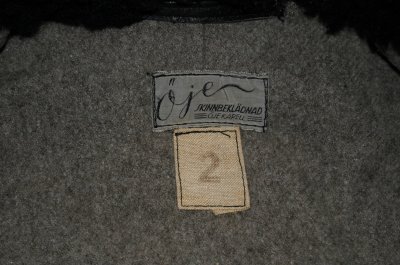
I have been wearing my Swedish coat in pouring rain many times, and it never leaves any stains of colour on my neck or wrists, or inner cladding. And when dry again, it stays deep black, without any softening of the colour. Still it would be nice to know if it was a chrome tanned coat, or a veg ditto. But how to find out?

Maybe some of the military flight jacket experts will be able to answer this but is was always my understanding that the very first flight jackets were made from veg tanned leather but they just didn't hold up very well under wet conditions. This is why they were switched to chrome tanned.
Back on topic......
one issue BTTs excellent and informative post doesn't address is the (frequently alleged) inability of veg tanned leather to resist water. I've read in several places that veg tanned doesn't repel water as well as chromed, and even worse, that it stains if you wear it in the wet. So is this also something to which the chicken dinner analogy applies? i.e. does this also depend on what veg tanned hide and from where? I've always suspected it is a myth at worst, exaggeration at best, but I'd dearly like to know for sure.
I'm actually thinking of buying a veg tanned jacket and I definitely need to wear it in the rain!
wild_balls
Practically Family
- Messages
- 600
- Location
- WESTCOAST OF SWEDEN
still on topic
I have been wearing my Swedish coat in pouring rain many times, and it never leaves any stains of colour on my neck or wrists, or inner cladding. And when dry again, it stays deep black, without any softening of the colour. Still it would be nice to know if it was a chrome tanned coat, or a veg ditto. But how to find out?
View attachment 11152
Hi,
I think it's chrome tanned! I have read that when the demand for leather was high here in Sweden they did not have the time to wait for veg tanned tanned hides as they took longer to prepare! I might be wrong, but I just read about it on an historian site about Swedish leather from 1800 til now!
Cheers Joakim
alsendk
A-List Customer
- Messages
- 427
- Location
- Zealand Denmark
Thanks John!
That's pretty fascinating. I definitely get the impression that, like "mil-spec" some dealers play off Veg Tanning as some sort of proof of genuineness, almost like saying "They don't make 'em like this anymore".
It's a little disappointing to know that veg tanning, while beautiful, isn't quite authentic for WWII jackets, if a true reproduction is what you are looking for, speaking personally.
Good to know though and John's post should be stickied since this is certain to not be the last time this question gets asked.
Deacon
That's pretty fascinating. I definitely get the impression that, like "mil-spec" some dealers play off Veg Tanning as some sort of proof of genuineness, almost like saying "They don't make 'em like this anymore".
It's a little disappointing to know that veg tanning, while beautiful, isn't quite authentic for WWII jackets, if a true reproduction is what you are looking for, speaking personally.
Good to know though and John's post should be stickied since this is certain to not be the last time this question gets asked.
Deacon
Good to know though and John's post should be stickied since this is certain to not be the last time this question gets asked.
+1
andyfalzon
Vendor
- Messages
- 422
- Location
- europe
Nice thread.
Indeed the A-2 specifications called for chrome tanning which has been already prevailing at the time.
But is there a difference of value between chrome and veg tanned leathers?.
We at BK follow the Italian school of thought and we believe that "yes there is".
There are many web pages dedicated to the sucject of explaining the advantages and disadvatages of each to show which one is the best.
There is no question which one is best. The market clearly defines it by the price each one is sold.
I will not bore you with too much information but I will focus on a few key points.
First, 90% of all leathers are tanned with chrome and the rest 10% with vegetables.
That alone should be able to tell you which is more more pricey.
Secondly, to make chrome tanned leathers you throw in a bunch of chemicals, press a button, wait a day and it's ready.
To make a veg tanned leather, only natural tanning agents are used. You should be able to understand that these natural ingredients do not exist in huge quantities, are hard to find and therefore more expensive.
Then you need the experienced and skilled artisans who will do most of the process by hand.
Also, it will take from 40 to 90 days (or longer) to tan the leathers. So what do you get?
You get much less product for the same production time. Why do it then if the final product will be the same as chrome tan?
Because it is not. The veg tanned leather, besides being produced with the natural way, looks and feels much more natural and that is the value that the market appreciates and pays for it.
And since the cost to produce it is higher than chrome tanned so will its price.
We have seen examples where veg. tanned leather costs 5 times more than chrome tanned.
But you will never see chrome tanned cost more than veg. tanned. This is by no means an accident.
So the dealers don't play off veg tanning as some sort of proof of genuineness. This is a misconception.
They give you they quality you are expected to buy for the asking price.
some of the pros and cons are of veg tanned are
-100% natural
-Due to the natural tannins used, vegetable tanned products actually improve with age and develop a patina.
-Each skin that is dyed using vegetable tanning is completely unique.
-The colours that vegetable tanning produces are rich and warm tones that look completely natural.
-The colours you can produce from vegetable tanning are limited.
-Direct heat can cause vegetable tanned leather to shrink or crack. (so don't iron your jacket)
some of the pros and cons are of chrome tanned are
-Stain resistant and water can roll off the surface easily.
-Colour remains the same throughout the products life (the finish may not)
-It's cheaper to buy than vegetable tanned leather, which means it is also easier to find.
-It has a high degree of thermal resistance.
-It doesn't wear very well or last long and can crack after a few months of use.
-Chrome tanning often smells of chemicals.
-It doesn't appear (neither is it) very natural.
Another thing of importance is that it is not only the tanning method that gives value to the veg tanned leather, but also the quality of the raw material itself.
Of course, it should be clear that it does not make much sense to take a bad quality leather and have it veg. tanned.
So what happens? Leather merchants know that veg tanners are going to need to use high quality leathers, and they will come looking for them, so they keep the best 10% leathers for them because they can sell those leathers to the veg tanners at higher price.
The leathers that they use are the so called full grain. Those are the leathers that maintain their original grain intact and look the most natural.
They select them carefully so that they get the best hides they can. Then you have top grain. This is the second best quality. It has much of the original grain removed by sanding or other methods to remove the imperfections but it's still good leather.
It is less expensive than full grain. Top grain leathers mainly go for chrome tanning but veg tanned exist also.
In much the same way, it does not make sense to take a full grain leather and have it chrome tanned when you can have it veg tanned and sell it for more money.
Lastly, it is the finish and dyeing method. In a nutshell, there are 3 types. Aniline, semi-aniline and pigment.
The first method involves bath dyeing the leather so that that there is no top coat paint and the natural surface of the leather and the grain remain visible and intact.
This method is associated with veg tanning and the most prefered method of the veg tanners. (Why go into the trouble of producing hides the natural way if they are not going to look natural?)
Second is semi-aniline which starts with aniline dyeing and finishes with a thin coating of pigment to give the leather a uniform color. Used on second quality leathers again to hide imperfections.
And last there is pigment which is used on the lower quality hides and its appearance is what you see on the less natural looking leathers that look like if they have been spray painted.
There are other things used on finishing the leathers, like waxes and lacquers and whatever the secret recipe of the tanners may provide for.
Leathers are also ironed flat by use of hot rollers which depending on the temperature used give less or more shine to the leather.
Regarding whether horsehide is better than cowhide I will agree with buzzthetower that they are both fantastic and that it is the tannery who makes the difference and we have seen cowhide looking much better than your ordinary horsehide.
About front quarter, actually tanneries do not use any "front quarter" term per se. Tanneries sell horsehide either in horsefront (front quarter is half of that) sides or butts.
All of the above are suitable for garments and whatever you buy there is no difference in price whatsoever. Whether you can take the cordovan and make expensive shoes with it that is completely another matter (not of the tannery's concern).
If a jacket maker buys horsefront, that is 2 x front quarter so he falls into the FQHH category. If he buys sides, then again the leather used in your jacket will contain FQHH.
Butts are big pieces of hide that account for 2/3 of sides so again leather that is found in the front quarter are included in those pieces. So either way you look at it, it's all FQHH.
Andy
www.billkelsomfg.com
That's pretty fascinating. I definitely get the impression that, like "mil-spec" some dealers play off Veg Tanning as some sort of proof of genuineness, almost like saying "They don't make 'em like this anymore".
It's a little disappointing to know that veg tanning, while beautiful, isn't quite authentic for WWII jackets, if a true reproduction is what you are looking for, speaking personally.
Good to know though and John's post should be stickied since this is certain to not be the last time this question gets asked.
Deacon
Indeed the A-2 specifications called for chrome tanning which has been already prevailing at the time.
But is there a difference of value between chrome and veg tanned leathers?.
We at BK follow the Italian school of thought and we believe that "yes there is".
There are many web pages dedicated to the sucject of explaining the advantages and disadvatages of each to show which one is the best.
There is no question which one is best. The market clearly defines it by the price each one is sold.
I will not bore you with too much information but I will focus on a few key points.
First, 90% of all leathers are tanned with chrome and the rest 10% with vegetables.
That alone should be able to tell you which is more more pricey.
Secondly, to make chrome tanned leathers you throw in a bunch of chemicals, press a button, wait a day and it's ready.
To make a veg tanned leather, only natural tanning agents are used. You should be able to understand that these natural ingredients do not exist in huge quantities, are hard to find and therefore more expensive.
Then you need the experienced and skilled artisans who will do most of the process by hand.
Also, it will take from 40 to 90 days (or longer) to tan the leathers. So what do you get?
You get much less product for the same production time. Why do it then if the final product will be the same as chrome tan?
Because it is not. The veg tanned leather, besides being produced with the natural way, looks and feels much more natural and that is the value that the market appreciates and pays for it.
And since the cost to produce it is higher than chrome tanned so will its price.
We have seen examples where veg. tanned leather costs 5 times more than chrome tanned.
But you will never see chrome tanned cost more than veg. tanned. This is by no means an accident.
So the dealers don't play off veg tanning as some sort of proof of genuineness. This is a misconception.
They give you they quality you are expected to buy for the asking price.
some of the pros and cons are of veg tanned are
-100% natural
-Due to the natural tannins used, vegetable tanned products actually improve with age and develop a patina.
-Each skin that is dyed using vegetable tanning is completely unique.
-The colours that vegetable tanning produces are rich and warm tones that look completely natural.
-The colours you can produce from vegetable tanning are limited.
-Direct heat can cause vegetable tanned leather to shrink or crack. (so don't iron your jacket)
some of the pros and cons are of chrome tanned are
-Stain resistant and water can roll off the surface easily.
-Colour remains the same throughout the products life (the finish may not)
-It's cheaper to buy than vegetable tanned leather, which means it is also easier to find.
-It has a high degree of thermal resistance.
-It doesn't wear very well or last long and can crack after a few months of use.
-Chrome tanning often smells of chemicals.
-It doesn't appear (neither is it) very natural.
Another thing of importance is that it is not only the tanning method that gives value to the veg tanned leather, but also the quality of the raw material itself.
Of course, it should be clear that it does not make much sense to take a bad quality leather and have it veg. tanned.
So what happens? Leather merchants know that veg tanners are going to need to use high quality leathers, and they will come looking for them, so they keep the best 10% leathers for them because they can sell those leathers to the veg tanners at higher price.
The leathers that they use are the so called full grain. Those are the leathers that maintain their original grain intact and look the most natural.
They select them carefully so that they get the best hides they can. Then you have top grain. This is the second best quality. It has much of the original grain removed by sanding or other methods to remove the imperfections but it's still good leather.
It is less expensive than full grain. Top grain leathers mainly go for chrome tanning but veg tanned exist also.
In much the same way, it does not make sense to take a full grain leather and have it chrome tanned when you can have it veg tanned and sell it for more money.
Lastly, it is the finish and dyeing method. In a nutshell, there are 3 types. Aniline, semi-aniline and pigment.
The first method involves bath dyeing the leather so that that there is no top coat paint and the natural surface of the leather and the grain remain visible and intact.
This method is associated with veg tanning and the most prefered method of the veg tanners. (Why go into the trouble of producing hides the natural way if they are not going to look natural?)
Second is semi-aniline which starts with aniline dyeing and finishes with a thin coating of pigment to give the leather a uniform color. Used on second quality leathers again to hide imperfections.
And last there is pigment which is used on the lower quality hides and its appearance is what you see on the less natural looking leathers that look like if they have been spray painted.
There are other things used on finishing the leathers, like waxes and lacquers and whatever the secret recipe of the tanners may provide for.
Leathers are also ironed flat by use of hot rollers which depending on the temperature used give less or more shine to the leather.
Regarding whether horsehide is better than cowhide I will agree with buzzthetower that they are both fantastic and that it is the tannery who makes the difference and we have seen cowhide looking much better than your ordinary horsehide.
About front quarter, actually tanneries do not use any "front quarter" term per se. Tanneries sell horsehide either in horsefront (front quarter is half of that) sides or butts.
All of the above are suitable for garments and whatever you buy there is no difference in price whatsoever. Whether you can take the cordovan and make expensive shoes with it that is completely another matter (not of the tannery's concern).
If a jacket maker buys horsefront, that is 2 x front quarter so he falls into the FQHH category. If he buys sides, then again the leather used in your jacket will contain FQHH.
Butts are big pieces of hide that account for 2/3 of sides so again leather that is found in the front quarter are included in those pieces. So either way you look at it, it's all FQHH.
Andy
www.billkelsomfg.com
- Status
- Not open for further replies.
Similar threads
- Replies
- 6
- Views
- 917
- Replies
- 15
- Views
- 2K
- Replies
- 9
- Views
- 986
- Replies
- 0
- Views
- 230
